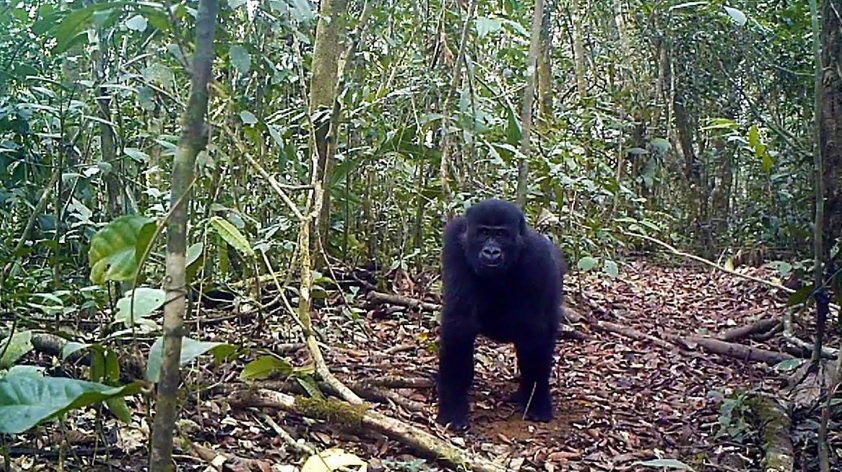
Gorillas in the Ebo forest, Cameroon
In late 2019, our Central Africa Program team installed 20 trail cameras in the Ebo forest, Cameroon. These cameras were installed in a very specific area of around 15 square miles of very mountainous terrain, which is home to around 15-25 of what might be the rarest form of gorilla – the Ebo gorillas.
These gorillas are separated from other gorilla populations to the north (the Cross River gorillas) and to the south (the western lowland gorillas) by several hundred miles. The Ebo gorillas are therefore an isolated ‘island’ population which may have been separated for many years, since human populations and development cut them off from the adjacent gorilla populations.
When we first came across these gorillas in 2002, their ‘discovery’ was met with great surprise in the primatological world, and marked what was to become a life’s work to protect these gorillas by the Central Africa Program team. Despite viewing a group for several incredible hours on that occasion, it took another 14 years to capture them on film!
Our more recent camera installations have allowed us to not just get great still shots of the individuals, but also provided us with videos of the animals moving through the forest- often using the same forest routes as chimpanzees, and showing just how much the overlap can be between two of our closest animal cousins.
Installing cameras in rainforests is not straightforward. Although there are three communities within 5 miles of the gorillas, none of them have electricity, running water or good road access, and become cut off from the rest of the world in the rainy season when the roads become impassable due to mud, and the makeshift plank bridges crossing stream and rivers are washed away.
We often have to trek to reach the villages, before even entering the forest, and it has taken many years of working with the communities to develop the trust and rapport that has allowed us to enter the forest regularly to study and work to conserve the range of magnificent animals in this very special forest.
In 2012, we started to work with the three communities in earnest, establishing ‘Club des Amis des Gorilles’ (Gorilla Guardian Clubs) in each village. These clubs engage in three main activities.
First, one or two members help our trained field assistants to monitor the gorilla habitat on a monthly basis, to record signs of gorillas and threats to them over time. Second, the clubs organize community engagement activities such as storytelling, discussions, film shows, and involve local schoolchildren to spread and embed the positive benefits of looking after the forest and wildlife. Third, we support these clubs in their efforts to improve lives in these challenging communities, by supporting small-scale sustainable livelihood projects such as cocoa farming, beekeeping, poultry farming and soap-making.
All these activities have now been in place since 2012, and are starting to reap real dividends in terms of improving lives, increasing knowledge and saving wildlife.
The most recent project was developed with the gorilla guardian clubs in two of these three communities – to install 20 cameras in the habitat close to their communities to try and capture wildlife on camera and to share this information with the communities in an effort to engender knowledge and pride. Many of these species have been hunted for many years, and most are never seen alive by many people in the villages including most women and children.
The impact that some of the pictures and behaviors seen cannot be underestimated – there is something very special about looking into a gorilla’s eyes and noticing the shared curiosity.
Of course, we imagine that this information gained from these cameras will also have other uses – to inventory what is in the forest, for example, and to calibrate our data from other field-based recording methods that we use. We are even hoping that with time we may be able to identify individual gorillas from these photographs in order to determine exactly how many gorillas are in the forest, and their possible relationships to each other.
In the meantime, though, we are enjoying some of the first photographs from these trail cameras, and also enjoying sharing them with the communities and seeing the look of amazement on the children’s faces, as the animals that they are hearing so much about are finally starting to reveal their identities during the film shows that we hold in the communities. While there is no electricity in the villages, we carry a generator and projector, and are able to share the wonders of the forest with all.
In addition to gorillas, we have captured a host of other fascinating forest animals. We plan to share some of these creatures with you in future blogs over the coming months, hoping that you will enjoy and be inspired by the amazing environment that is the African rainforest.













